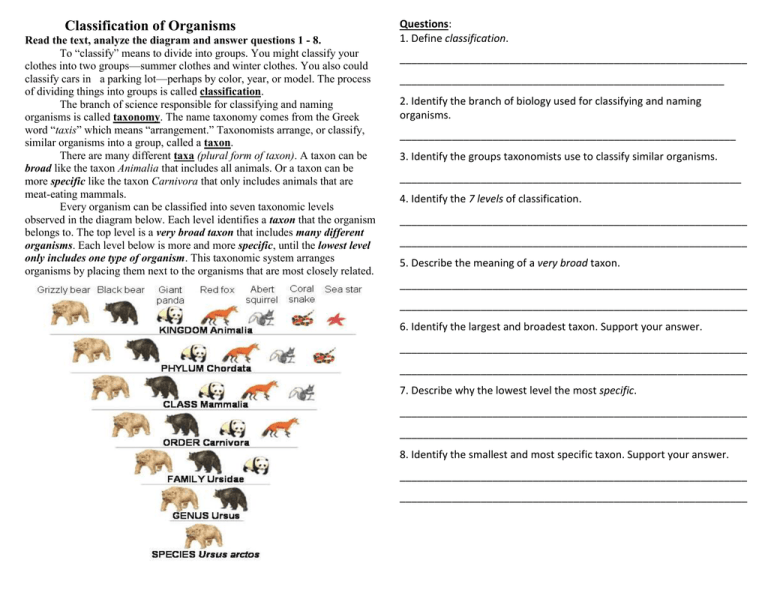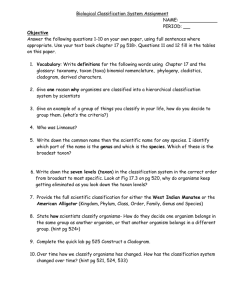Classification
advertisement

Classification of Organisms Read the text, analyze the diagram and answer questions 1 - 8. To “classify” means to divide into groups. You might classify your clothes into two groups—summer clothes and winter clothes. You also could classify cars in a parking lot—perhaps by color, year, or model. The process of dividing things into groups is called classification. The branch of science responsible for classifying and naming organisms is called taxonomy. The name taxonomy comes from the Greek word “taxis” which means “arrangement.” Taxonomists arrange, or classify, similar organisms into a group, called a taxon. There are many different taxa (plural form of taxon). A taxon can be broad like the taxon Animalia that includes all animals. Or a taxon can be levels—kingdom, phylum, class, order, family, genus, more specific like the taxon Carnivora that only includes animalsand thatspecies. are meat-eating mammals. can be that classified into seven levels level is aEvery veryorganism broad taxon includes mantaxonomic y different organisms. observed in the diagram below. Each level identifies a taxon that the organism belongs The top level a veryofbroad taxon thatThis includes many different level onlyto.includes oneis type organism. taxonomic system organisms. Each level below is more and more specific, until the lowest level arranges organisms by placing them next to the organisms that are only includes one type of organism. This taxonomic system arranges most closely related. organisms by placing them next to the organisms that are most closely related. Questions: 1. Define classification. ____________________________________________________________ ________________________________________________________ 2. Identify the branch of biology used for classifying and naming organisms. __________________________________________________________ 3. Identify the groups taxonomists use to classify similar organisms. ___________________________________________________________ 4. Identify the 7 levels of classification. ____________________________________________________________ ____________________________________________________________ 5. Describe the meaning of a very broad taxon. ____________________________________________________________ ____________________________________________________________ 6. Identify the largest and broadest taxon. Support your answer. ____________________________________________________________ ____________________________________________________________ 7. Describe why the lowest level the most specific. ____________________________________________________________ ____________________________________________________________ 8. Identify the smallest and most specific taxon. Support your answer. ____________________________________________________________ ____________________________________________________________ 5. A. Describe the organization of this diagram. Binomial Nomenclature Read the text and answer questions 9 - 21. Before the 1700’s, scientists had not yet agreed on the way to name living organisms. Most animals had common names like cat or dog, but using common names was confusing and made communication about organisms difficult. One problem with common names is that they are not reliable — they can be misleading. For example, a “sea cucumber” sounds like a vegetable but it is actually an animal. A “sea horse” is not a horse at all – it is actually a fish. Another problem with common names is that some living organisms have many different common names. For example, a cougar is commonly called a puma, a catamount, and even a mountain lion. Scientists needed a reliable system of naming organisms — a taxonomy — that would make it easier to communicate with each other about organisms. An early system of taxonomy used Latin words to describe what an organism looked like. However, this had problems, too. Latin names were too long and hard to remember. Also, scientists around the world often named the same organism using different Latin descriptions. Some scientists named the common briar rose Rosa sylvestris inodora seu canina, which means “odorless woodland dog rose” in Latin. Other scientists called the briar rose Rosa sylvestris alba cum rubore, folio glabro which means “pinkish- white woodland rose with hairless leaves.” Scientists needed a way to make naming organisms more consistent around the world. The system of taxonomy used today was first introduced by Carl Linnaeus, a Swedish naturalist who lived in the 1700’s. He proposed that each organism be given a two-part scientific name based upon its classification. This system of naming became known as binomial nomenclature. The first part of any organism’s name is its genus. An organism’s genus name allows scientists to immediately recognize what other organisms it is related to. The second part is the organism’s individual name, the organism’s species, allows scientists to recognize the specific organism. For example, a cougar’s scientific classification is Puma concolour. Questions: 9. Identify the types of names that were confusing to use. __________________________________________________________________ 10. Explain why using taxonomy was a better method for naming organisms. _________________________________________________________________ _________________________________________________________________ ____________ 11. Identify the language used to describe an organism’s appearance._____________ 12. Describe the disadvantage of using Latin words to describe organisms looked like. ______________________________________________________________________ ______________________________________________________________________ 13. Identify the inventor of the present system of taxonomy. ___________________ 14. Identify the current system of naming organisms. ________________________ 15. Identify 1st part of the scientific name. _________________________________ 16. Identify 2nd part of the scientific name. _________________________________ 17. The scientific name for a cougar is Puma concolour. Identify its genus and species. Genus: ______________________ Species: ___________________________ For questions 18-21 identify the genus and species for each scientific name. 18. Panthera leo (lion) 19. Procyon lotor (racoon) 20. Drosophila melanogaster (fruit fly) 21. Tursiops truncatus (dolphin)



